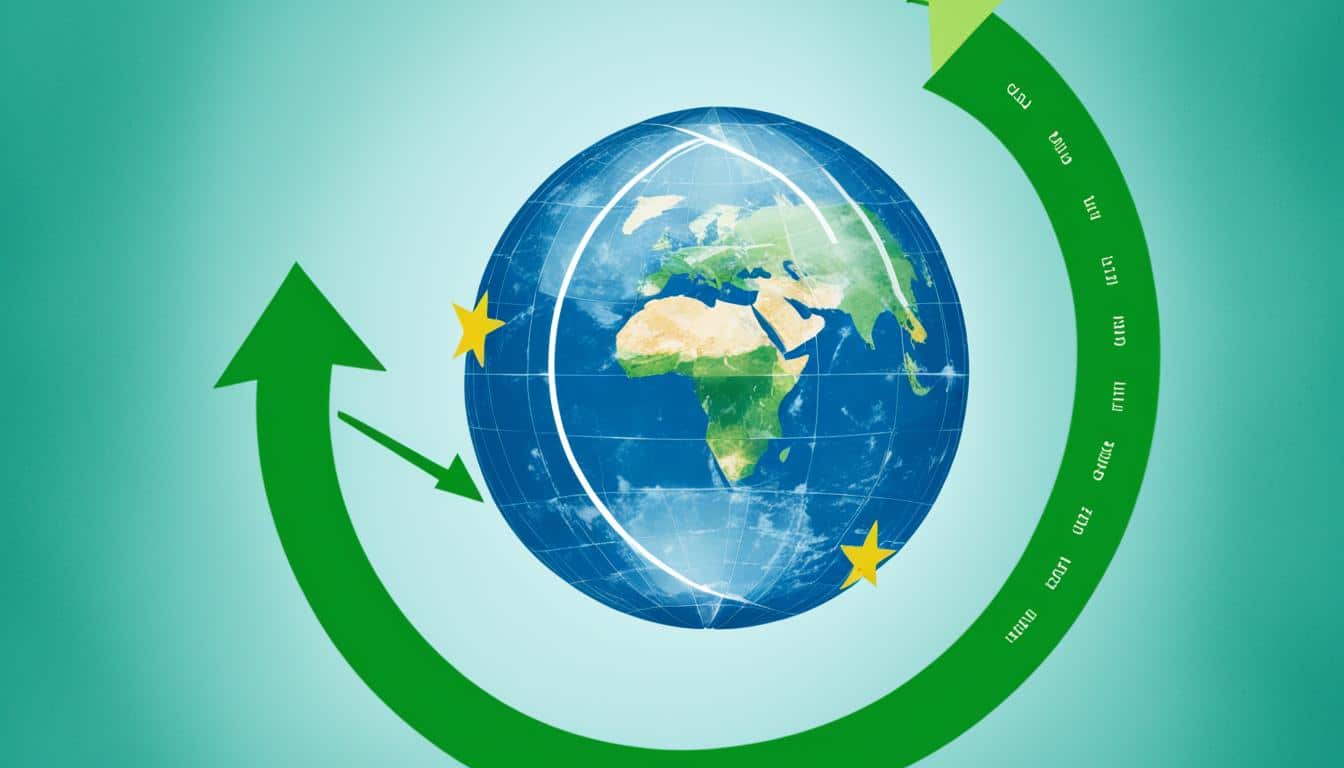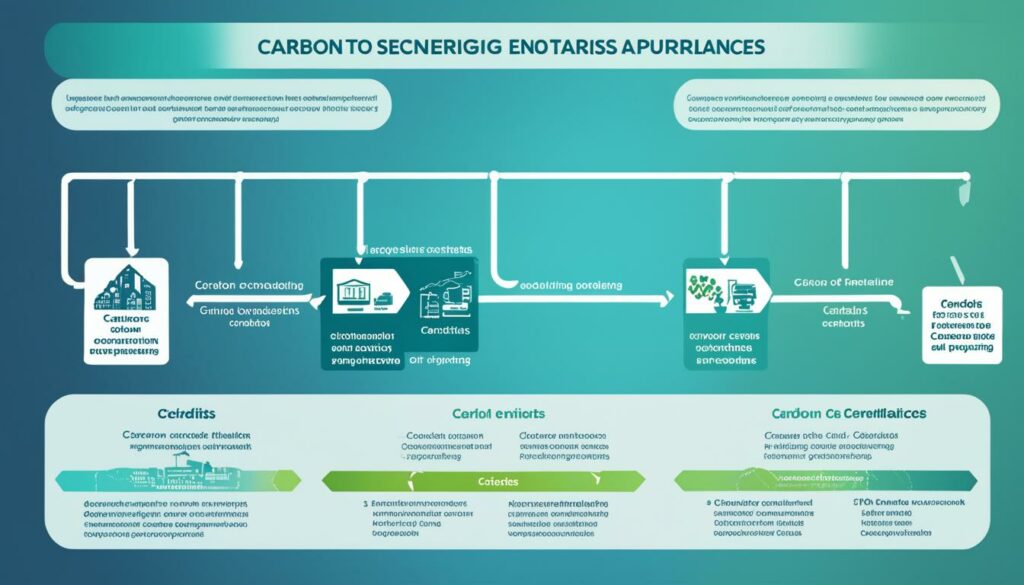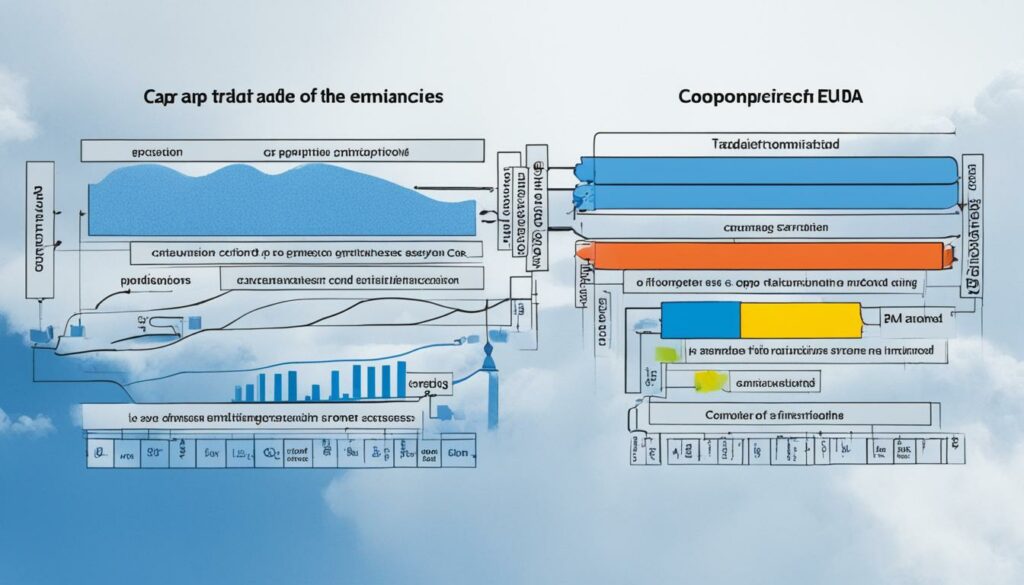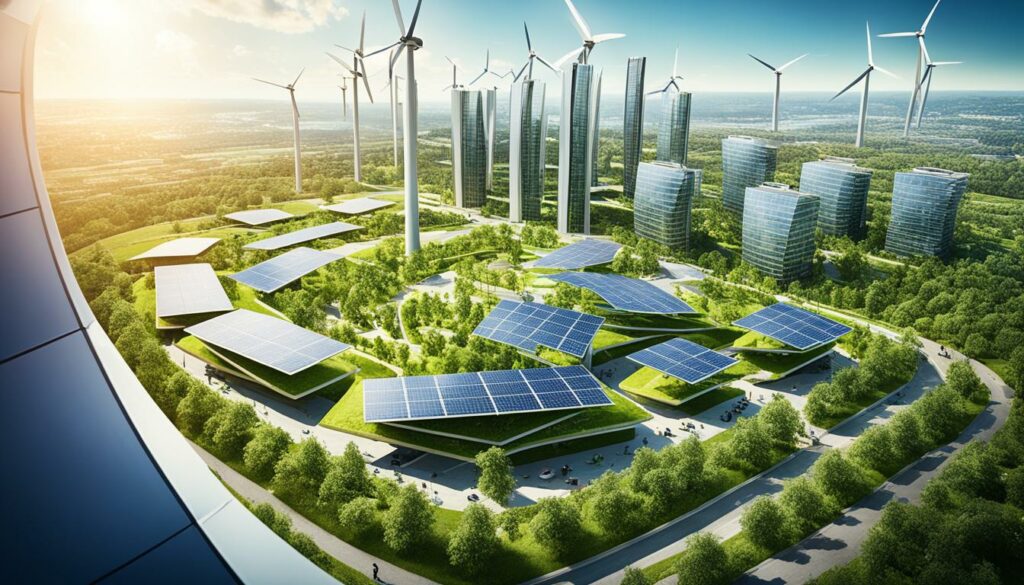Menu

Did you know that the EU Emissions Trading System (EU ETS) deals with almost half the EU’s greenhouse gases? It’s the first big carbon market in the world and the biggest, covering all EU nations plus Iceland, Liechtenstein, and Norway. Since it started in 2005, the EU ETS has helped cut down emissions from power and industrial sites by 37%.
The EU ETS works by setting a polluting limit and making it lower every year. This way, it gradually cuts the amount of greenhouse gases let into the air. By using market forces, it pushes companies to pollute less, which matches the EU’s big aims for the climate. Since 2013, it has made over €152 billion. This money goes back into clean energy and energy-saving projects. It helps the EU move more towards a green, less-carbon future.
The EU Emissions Trading System (EU ETS) is a vital part of Europe’s effort to cut emissions. It includes all EU countries and some others like Iceland. This system works with more than 11,000 places that produce a lot of greenhouse gases.
The EU ETS is the first big plan in the world to trade emissions. It sets a limit on how much greenhouse gas a business can produce. Every year, this limit gets smaller, making companies cut down their emissions. Businesses can buy or sell emissions allowances. This helps lower costs and push for cleaner ways to work.
The EU ETS started in 2005 and has since made big steps to lower CO2. The first step alone cut 200 million tonnes of CO2. It’s now on its fourth phase, aiming to drop greenhouse gases by 40% before 2030. This shows how well Europe tackles emissions trading.
The EU Emissions Trading System (EU ETS) is a system that focuses on simple market trading for carbon. It aims to lower greenhouse gases in Europe. It covers all EU nations, and also Iceland, Liechtenstein, and Norway, with a focus on limiting emissions from around 11,000 sites. This includes big factories, power stations, and airlines in the European Economic Area (EEA).

The core method of the EU ETS is ‘cap and trade’. A limit is placed on the total amount of greenhouse gases allowed. This limit gets smaller every year, pushing for less pollution. Companies must get emission allowances for their emissions. An allowance lets them emit one tonne of CO2 equivalent (CO2eq).
Companies can get these allowances in a few ways. They might get them for free, buy them at EU ETS auctions, or trade for them on the carbon market. All this trading is done online to keep track of who owns the allowances. If a company has more allowances than it needs, they can sell them. This helps to keep the market fair and efficient.
Adhering to the EU ETS rules is closely watched. Companies must hand over enough carbon allowances each year or pay heavy fines. This pushes companies to pollute less. It encourages them to find new ways to cut emissions and use cleaner tech. As the limit on emissions gets tighter, the price of allowances goes up. This makes investing in reducing pollution more financially attractive.
The EU ETS manages a complex system with strict rules. This system plays a crucial role in meeting the EU’s environmental goals.
| Phase | Years | Key Features |
|---|---|---|
| Phase One | 2005-2007 | Primarily free allocation, pilot phase to test system design. |
| Phase Two | 2008-2012 | Included aviation, introduction of limited auctions, about 3% of allowances auctioned. |
| Phase Three | 2013-2020 | Increased auctioning, up to 57% of allowances auctioned, sector-specific performance benchmarks for free allocation. |
| Phase Four | 2021-2030 | Further increased auctioning, buffer for unexpected needs, free allocation based on updated benchmarks, support for innovative projects. |
Its strong structure and strict management make the EU ETS a key part of cutting emissions in the EU.
The carbon trading scheme is key in the EU’s fight against climate change. It controls the amount of greenhouse gases big emitters can produce. This includes power plants, factories, and airlines. Each emission allowance gives the right to emit one tonne of CO2.
It works through a market system. This means companies can trade their emission allowances to meet their limits. By trading, they set a price for carbon. This price encourages them to find new ways to be greener. It turns being eco-friendly into saving and making money.
The EU’s goal is to keep reducing emissions every year. By 2026, all industries, including shipping, will be fully covered. This shows the EU’s push to lower emissions by 55% by 2030 and be carbon neutral by 2050.
In 2024, all ships will start joining the trading system bit by bit. They will need to buy enough EUAs for their annual emissions. This includes gases other than CO2. This step shows how serious Europe is about limiting emissions.
Here’s how the EU ETS plans to include more sectors over time:
| Year | Emissions Coverage | Sectors Included |
|---|---|---|
| 2024 | 40% | Power plants, industrial installations, initial shipping phase |
| 2025 | 70% | Enhanced shipping inclusion, airlines, additional industrial sectors |
| 2026 | 100% | Full sector integration including shipping, full phase-in of methane and nitrous oxide |
The carbon trading scheme pushes companies to be greener. It encourages them to use clean tech. This helps meet rules and shows they care about the planet. This system is a big part of the EU’s plan to fight climate change.
The EU Emissions Trading System uses the Cap and Trade Principle. This key rule works to lower greenhouse gas emissions within the European Union. It puts a strict limit on emissions for over 11,000 sites, such as power and industrial plants.

The basis of the Cap and Trade Principle is ‘Setting the Cap’. It means putting a top limit on the emissions allowed from factories and airlines. This limit reduces every year as the EU aims higher to fight climate change.
Entities covered by this must get carbon allowances for about 45% of the EU’s emissions. They can buy these allowances from trading or at EU ETS auctions.
This system’s trading part is key for cutting costs in reducing emissions. If a company has more allowances than it needs, it can sell them. Others can buy these if they’re short. This keeps the trading market moving, making sure prices match what’s available and needed.
The system includes countries like Iceland, Liechtenstein, and Norway. It aims to make managing emissions more efficient. The EU also puts big fines on companies that don’t hand in enough allowances. This makes the Cap and Trade Principle stronger.
The table below summarises the key metrics of the EU ETS:
| Aspect | Details |
|---|---|
| Coverage | 45% of EU’s greenhouse gas emissions |
| Installations | 11,000+ |
| Participating Countries | EU-27, Iceland, Liechtenstein, Norway |
| Operators | Power stations, industrial plants, airlines |
| Penalties | Heavy fines for non-compliance |
The EU Emissions Trading System (ETS) has strict rules to work better and fairer. These rules help make sure companies follow carbon market laws in Europe. The main aim is to cut greenhouse gas emissions by 55% by 2030 and reach net zero by 2050.
Companies get an EU Allowance (EUA) for each tonne of GHGs they can emit. From 2021 to 2030, they must cut emissions by 2.2% every year. This rule applies to industries, ships, and planes. They must track and report their emissions precisely to the carbon market.
The EU ETS now watches over the shipping industry too. Starting in 2024, 40% of their emissions are covered. This will be all emissions by 2026. Companies must keep a close eye on their emissions and report them on time to avoid fines.
If companies don’t follow the rules, they face big penalties. Missing the deadline to hand in emissions certificates costs EUR 100 per tonne. This fine goes up each year to keep the carbon market effective.
There are also rules about how free allowances are given and how auctions work. Some countries, such as Bulgaria, Hungary, and Romania, get free allowances for their energy sectors until 2030. The money from auctions goes to reducing emissions in other ways and funds for innovation and modernisation.
| Aspect | Details |
|---|---|
| Annual GHG Reduction Target by 2030 | 55% compared to 1990 levels |
| Net Zero Emissions Target | 2050 |
| Shipping Sector Inclusion | 40% coverage by 2024, 100% by 2026 |
| Non-Compliance Penalty | EUR 100 per tonne, adjusted annually |
| Annual Reduction Factor (Phase 4) | 2.2% |
| Free Allowances Allocation | Energy sector in Bulgaria, Hungary, Romania up to 2030 |
EU ETS regulations set a strong foundation for a working market. They play a key role in reaching the EU’s environmental targets.
Since 2005, the EU Emissions Trading System (EU ETS) has greatly cut down on greenhouse gas emissions. Companies in the EU need to give up carbon allowances every year to follow strict climate rules. This system is working well, making big steps towards a carbon-neutral world.

The EU ETS has cut emissions by 37% from power and industry since it began. It includes about 45% of the EU’s total emissions, regulating over 11,000 sites. These include power plants, cement works, and even airlines. By setting these limits, the EU ETS has brought down pollution, showing how focused laws can help our planet.
The EU ETS aims to lower emissions even more in the future. With the current plan, emissions should fall to 856.85 million tonnes by 2030. Possible extra steps could push this figure to 774 million tonnes. The EU is determined to achieve a 62% reduction by 2030 from 2005’s levels. Its strategy helps cut emissions every year and drives innovation and clean energy investment.
| Year | Historical Emissions (Million Tonnes) | Projected Emissions with Existing Measures (Million Tonnes) | Projected Emissions with Additional Measures (Million Tonnes) |
|---|---|---|---|
| 2005 | 2093 | ||
| 2020 | 1253 | ||
| 2021 | 1337 | ||
| 2022 | 1318.41 | 1298.32 | |
| 2030 | 856.85 | 774 |
The EU ETS has also seen drops in emissions from the fuel burning sector, making up 60% of total emissions. From 2025 to 2028, there’s a worry emissions could go beyond current limits. This shows a continuous need to update policies and invest in cleaner tech. Air travel’s impact has grown, especially after COVID-19. Yet, the EU ETS remains strong, supporting the EU’s goal for zero net emissions.
The EU Emissions Trading System (ETS) is key in the EU’s fight against climate change. It’s part of a wider strategy focused on protecting our planet. The ETS also plays well with other EU climate actions.
The EU climate policy’s heart is the ETS. It adapts over time to meet new environmental and economic challenges. In the second phase of the ETS, most allowances were free. But by the third phase, auctioning was the main way to get these allowances, aiming for more market-driven emissions cuts.
In the third phase of the ETS, 15% of allowances went to aviation via auctions. Another 82% were given for free to stop companies moving their production outside the EU. This smart approach made sure different industries followed the rules and encouraged cleaner practices.
The ETS works with other emissions trading in Europe actions. It supports things like renewable energy and energy-saving tech. As we move into the fourth phase, auctions will still be crucial. But some industries will start losing their free allowances, slowly, from 2026. This change supports a fairer global competition.
Phase Four adds over 450 million allowances to prevent shortages. It also uses new free allocation rules based on past activities. This makes the system more flexible and effective in managing emissions.
Starting from October 2023, the EU’s Carbon Border Adjustment Mechanism (CBAM) will track emissions from electricity imports. This move strengthens the links between the ETS and other important policies. Together, they aim for a more sustainable, low-carbon future.
Emission allowances are key in the EU’s carbon trading. Each one lets you emit a tonne of CO2eq. They are either given freely or sold through EU ETS auctions.

From 2021 to 2030, the EU ETS cap on emissions drops by 2.2% each year. This is more than the 1.74% drop from 2013 to 2020. It means there are fewer allowances each year, making it harder for companies to emit a lot.
In 2021, 1,571,583,007 allowances were auctioned, which is 57% of the total. The rest were given away. This makes the system fair and allows for trading, helping companies manage their emissions better.
If more free allowances are needed, a special rule kicks in to keep it fair. There’s a 3% buffer too. The extra ones are either given to funds or sold through auctions.
These allowances are based on certain values and risks. This makes sure everyone gets a fair share. It also helps cut down on emissions. Money from selling around 20 million allowances goes to the Innovation Fund. It supports cool, new things in shipping.
| Phase | Annual Cap Reduction | Allocation Method |
|---|---|---|
| Phase 3 (2013-2020) | 1.74% | Mix of Auctions and Free Allocation |
| Phase 4 (2021-2030) | 2.2% | 57% Auctions, 43% Free Allocation |
This whole system, along with the chance to trade, works well. It cuts down on harmful emissions. It also helps businesses change and grow.
The EU ETS uses a carbon pricing mechanism to fight climate change. It gives a price to carbon emissions. This method encourages companies to reduce their greenhouse gas emissions because it affects their profits.
The EU ETS market is shaped by many things like policies, tech changes, and the balance between supply and demand for emission allowances. Early on, most allowances were given for free. But later, less were given free to encourage a more market-driven approach.
Then, in Phase Three, over half the allowances were sold through auctions. This showed a move to a stronger market system. Also, to keep the aviation sector stable, most of their allowances were still given for free during a certain period.
| Phase | Free Allocation | Auctioned Allowances |
|---|---|---|
| Phase One | ~90% | 0% |
| Phase Two | ~97% | ~3% |
| Phase Three | ~43% | Up to 57% |
In Phase Three, a New Entrants’ Reserve was started. It was 5% of the total. This and new industry standards have changed how the market works. In Phase Four, there’s still significant free allocation. This is to protect against businesses moving away to avoid the carbon price.
The price of emission allowances changes based on the caps and responses in the market. For example, free allowances’ values were changed for 2021-2025. The plan is also to reduce free allowances for aviation until they stop getting any by 2026. This shows us allowance prices will likely go up.
The EU ETS affects nearly half of Europe’s greenhouse gas emissions sectors. This big reach impacts the market a lot, bringing in both new and old businesses. Also, the money collected goes to help fight climate change. This includes funding for clean vehicles and energy-saving projects, which can also change prices.
The EU is also working on a Carbon Border Adjustment Mechanism (CBAM). This will impact international trade to make sure countries outside the EU don’t have an unfair advantage. Sectors like cement and steel will slowly be brought into this system. The CBAM will add new factors to the price trends we see in the carbon market.
All these measures mean that the price of carbon allowances is a key sign of how well the market is working. It encourages investments in green technologies and ways of working.
The EU Emissions Trading System (EU ETS) is key to pushing carbon neutral projects across Europe. It helps move us towards a green future. It does this by putting strict limits on emissions and creating a market for carbon allowances. These steps lower harmful gas emissions. They also encourage using renewable energy and boosting how efficient our energy use is.

The EU ETS helps a lot in developing renewable energy. It uses money from selling emission allowances to fund green energy projects. This makes clean energy like wind, solar, and hydro power more affordable. They can grow more common. By 2026, the EU wants to provide EUR 86.7 billion for this through the Social Climate Fund. This will speed up the move to cleaner energy and improve how we use energy across Europe.
Another big role of the EU ETS is boosting energy efficiency. It makes companies that use lots of energy pay more. This pushes them to use energy more wisely. Using less energy helps cut down on harmful emissions. It also saves companies money in the end. Companies that work hard to be greener can also save money. This spreads the word about the benefits of sustainable methods.
The EU ETS helps a huge amount in making our carbon neutral dreams real. It not only pushes Europe but also shows the world how to fight climate change. This is done by supporting clean energy and making us save energy better. These are key plans for the EU to reach its 2050 goal: a green and zero-carbon economy.
The European Union Emissions Trading System (EU ETS) is crucial in changing how industries invest. It spans over 14,000 factories in 30 nations, impacting 40% of the EU’s emissions. By doing so, it affects firms’ economic activities profoundly.
It affects how companies make financial decisions by its carbon price. Companies can buy or sell emission permits to cut costs. Since mid-2020, the cost of these permits jumped to about EUR 80/tCO2. This was much higher than the past average of EUR 20/tCO2.
The money made from selling these permits helps fund environmental projects. This boosts economic growth and cuts emissions at the same time. It’s a win-win for EU countries.
Studies show the EU ETS didn’t hurt businesses financially. Instead, they made more money and cut emissions by 10% from 2005 to 2012. Employment didn’t suffer either, pointing to firms’ strength in the system.
In places like Germany and France, emission cuts didn’t harm jobs. Impact was positive on product values and labour efficiency. The EU ETS also encouraged more innovation in green technology.
Research on the EU ETS’s impact uses advanced methods to avoid misleading results. It concludes that the system isn’t just about cutting emissions. It also spurs economic and innovative growth under strict rules.
The EU Emissions Trading System (EU ETS) is key to driving innovations. It does this by offering economic benefits through its cap-and-trade system. Companies are pushed to use green technologies and sustainable methods. The Innovation Fund and the Modernisation Fund also help by providing targeted funding.
The EU ETS offers big incentives supporting green tech. The European Commission has set up 54 benchmarks for businesses, showing them the best ways to go. Sectors worried about losing business to other countries get all the benchmarks for free, cutting their costs. This support makes it easier for companies to use green tech, leading to more invention and less pollution.

Supporting low-carbon projects is central to the EU’s plan. The Innovation Fund, run by the European Commission, is a big part of this. CINEA and the European Investment Bank help manage it. CINEA invites proposals, checks them, and signs grants to make sure strong projects get help. The European Investment Bank also plays a key role, turning EU ETS allowances into money for the fund.
Local and national authorities, along with special National Contact Points in each EU country, are important for giving out information and backing local projects. Their help with funding reviews makes it easier for smart, eco-friendly ideas to grow and become real.
Table showcasing EU ETS in incentivising and funding:
| Aspect | Details |
|---|---|
| Managing Innovation Fund | European Commission, CINEA, European Investment Bank |
| Funding Mechanism | Innovation Fund, Modernisation Fund |
| National Support | National Contact Points, Government Support (National, Regional, Local) |
| Benchmarks | 54 industry benchmarks established based on 2007-2008 data |
| Carbon Leakage Safeguards | 100% free allowances for at-risk sectors |
| Project Development Assistance | Provided by European Investment Bank |
These combined efforts show how the EU ETS boosts innovation and helps turn green ideas into real solutions. This moves Europe towards its important climate targets.
The EU Emissions Trading System (EU ETS) plays a key role in the EU’s efforts to fight climate change. Yet, it is not without its challenges. Critics point to its market instability and the need for frequent policy changes.
The EU ETS faces a major hurdle in market volatility. The cost of carbon allowances can change a lot due to policy shifts and economic situations. This makes it hard for businesses to plan for the future when investing in clean technology.
The mean value of estimates of the social cost of carbon ranges around $30/tonne, with some studies reporting lower figures and others placing estimates over $400/tonne.
These ups and downs in prices cause instability, making it harder for the EU ETS to lower emissions effectively. Nonetheless, a stable and effective carbon market is needed to hit the EU’s bold climate goals. These include cutting emissions 55% by 2030 and achieving net-zero by 2050.
The EU has taken steps to tackle market insecurity. For instance, they set up the Market Stability Reserve (MSR) to manage surplus allowances. But, any policy changes must be carefully thought out to keep the market stable, without hurting the economy or innovation.
About 57% of the allowance cap in the EU ETS’s current phase is up for auction. The rest are given to companies for free. This helps keep industry competitive while encouraging cuts in emissions. But, the EU must keep adapting its policies to changing economic and environmental conditions. This shows the EU ETS needs constant attention and fine-tuning.
| Year | Key Policy Adjustment | Impact |
|---|---|---|
| 2015 | Market Stability Reserve (MSR) Introduction | Reduced surplus allowances, bolstered market stability |
| 2027 | New ETS for Buildings and Road Transport | Expanded coverage, targeting additional emissions sources |
| 2026 | Social Climate Fund Establishment | Support for vulnerable households during transition |
Some argue that giving certain industries, such as steel and cement, free carbon permits supports their global competitiveness. However, critics say this can unfairly benefit these companies, at the cost of taxpayers. Reports suggest some have made huge profits by cleverly using these free permits.
In summary, the EU ETS is crucial for the EU’s climate work. But, the challenges of market swings and constant policy updates require careful and active management.
The EU Emissions Trading System (EU ETS) has a massive global impact. Since starting in 2005, it’s led Europe’s fight against climate change. It’s also become a global model for cutting emissions.
One clear win is how emissions from big sites have dropped. From 2093 Mt CO2e in 2005, they shrank to 1337 Mt CO2e in 2021. By 2022, the numbers were even better, 24 Mt CO2e less than last year. They’ve hit a level 37% under 2005. This shows the EU ETS is working well and the EU is serious about its big climate goals for 2030.
But, there are still big challenges to come. It’s likely that, between 2025 and 2028, emissions might top the set limit. This would make reaching the 2030 goals harder. The EU ETS is set up to push for changes, like switching from coal to cleaner fuels and renewables. This model can help other places too.
As the world fights climate change, the EU ETS is a key player showing results. It stands as an example of global progress against climate change.
The EU ETS is key in the EU’s fight against climate change by managing greenhouse gas emissions. It uses a ‘cap and trade’ approach. This means it sets a limit on total emissions and lets the market push for cuts.
The EU ETS began in 2005 as the first global carbon market. Since then, it’s grown to be more effective and efficient. It’s done this by putting stricter limits on emissions and using more auctions to assign allowances.
The EU ETS limits emissions from 11,000 sites, which can buy or earn tradeable emission allowances. An allowance lets you emit a tonne of CO2. This makes companies look for ways to lower their emissions.
‘Cap and Trade’ is a policy for the environment. It limits emissions and lets companies trade allowances. The goal is to cut emissions and boost the economy over time.
The EU ETS is overseen by a strict legal setup. This framework sets caps and manages how allowances are shared out or sold. Companies in the scheme must accurately report their emissions each year or face fines.
By encouraging cuts in emissions, the EU ETS has lowered pollution by about 37%. It keeps pushing for cleaner practices by setting tighter limits and supporting new technology.
The EU ETS is a vital part of the EU’s wider climate plan. It works alongside other efforts, like increasing renewable energy and making industry more efficient. The goal is to meet the EU’s climate targets.
In the EU ETS, allowances can either be given out for free or sold at auctions. Companies can then swap their allowances with others. This system helps companies manage their emissions cost-effectively.
Under the EU ETS, carbon’s cost is set by the market. This makes companies think about their emissions because it adds to their costs. The idea is to encourage lower emissions in business decisions.
By making carbon-heavy activities more expensive, the EU ETS pushes for cleaner, greener practices. Money from selling allowances supports projects that are good for the planet.’
The EU ETS changes how industries invest and act through carbon prices. Money from auctions goes into eco-projects. This helps the economy grow while cutting pollution.
The ETS encourages using green tech by putting a price on emissions. It also supports research and green projects through funds, promoting new eco-friendly technology.
The EU ETS deals with issues like changing policies and market swings. To keep things steady, tools like the Market Stability Reserve help manage the market.’
The EU ETS is a leading example in the world for managing emissions. It has shaped how other parts of the globe think about their carbon markets. Its lessons are a key guide for fighting climate change on a global scale.